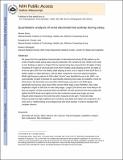Quantitative analysis of wrist electrodermal activity during sleep
Author(s)
Sano, Akane; Picard, Rosalind W.; Stickgold, Robert
DownloadPicard_Quantitative analysis.pdf (1.136Mb)
PUBLISHER_CC
Publisher with Creative Commons License
Creative Commons Attribution
Terms of use
Metadata
Show full item recordAbstract
We present the first quantitative characterization of electrodermal activity (EDA) patterns on the wrists of healthy adults during sleep using dry electrodes. We compare the new results on the wrist to the prior findings on palmar or finger EDA by characterizing data measured from 80 nights of sleep consisting of 9 nights of wrist and palm EDA from 9 healthy adults sleeping at home, 56 nights of wrist and palm EDA from one healthy adult sleeping at home, and 15 nights of wrist EDA from 15 healthy adults in a sleep laboratory, with the latter compared to concurrent polysomnography. While high frequency patterns of EDA called “storms” were identified by eye in the 1960s, we systematically compare thresholds for automatically detecting EDA peaks and establish criteria for EDA storms. We found that more than 80% of the EDA peaks occurred in non-REM sleep, specifically during slow-wave sleep (SWS) and non-REM stage 2 sleep (NREM2). Also, EDA amplitude is higher in SWS than in other sleep stages. Longer EDA storms were more likely to occur in the first two quarters of sleep and during SWS and NREM2. We also found from the home studies (65 nights) that EDA levels were higher and the skin conductance peaks were larger and more frequent when measured on the wrist than when measured on the palm. These EDA high frequency peaks and high amplitude were sometimes associated with higher skin temperature, but more work is needed looking at neurological and other EDA elicitors in order to elucidate their complete behavior.
Date issued
2014-10Department
Massachusetts Institute of Technology. Media LaboratoryJournal
International Journal of Psychophysiology
Publisher
Elsevier
Citation
Sano, Akane, Rosalind W. Picard, and Robert Stickgold. “Quantitative Analysis of Wrist Electrodermal Activity During Sleep.” International Journal of Psychophysiology 94, no. 3 (December 2014): 382–389.
Version: Author's final manuscript
ISSN
01678760